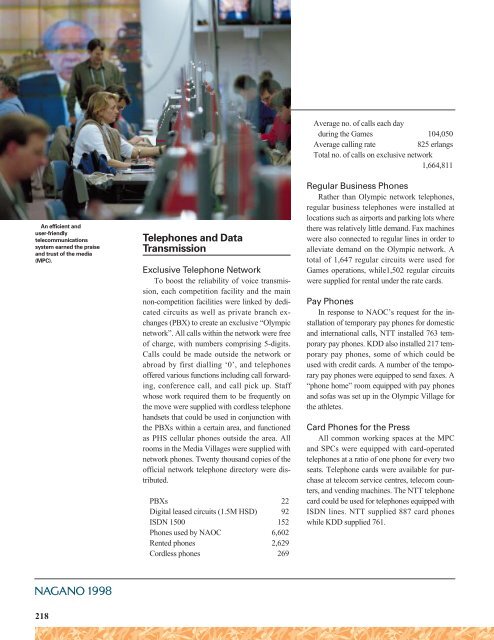107th IOC Session - LA84 Foundation
107th IOC Session - LA84 Foundation
107th IOC Session - LA84 Foundation
You also want an ePaper? Increase the reach of your titles
YUMPU automatically turns print PDFs into web optimized ePapers that Google loves.
An efficient and<br />
user-friendly<br />
telecommunications<br />
system earned the praise<br />
and trust of the media<br />
(MPC).<br />
218<br />
Telephones and Data<br />
Transmission<br />
Exclusive Telephone Network<br />
To boost the reliability of voice transmission,<br />
each competition facility and the main<br />
non-competition facilities were linked by dedicated<br />
circuits as well as private branch exchanges<br />
(PBX) to create an exclusive “Olympic<br />
network”. All calls within the network were free<br />
of charge, with numbers comprising 5-digits.<br />
Calls could be made outside the network or<br />
abroad by first dialling ‘0’, and telephones<br />
offered various functions including call forwarding,<br />
conference call, and call pick up. Staff<br />
whose work required them to be frequently on<br />
the move were supplied with cordless telephone<br />
handsets that could be used in conjunction with<br />
the PBXs within a certain area, and functioned<br />
as PHS cellular phones outside the area. All<br />
rooms in the Media Villages were supplied with<br />
network phones. Twenty thousand copies of the<br />
official network telephone directory were distributed.<br />
PBXs 22<br />
Digital leased circuits (1.5M HSD) 92<br />
ISDN 1500 152<br />
Phones used by NAOC 6,602<br />
Rented phones 2,629<br />
Cordless phones 269<br />
Average no. of calls each day<br />
during the Games 104,050<br />
Average calling rate 825 erlangs<br />
Total no. of calls on exclusive network<br />
1,664,811<br />
Regular Business Phones<br />
Rather than Olympic network telephones,<br />
regular business telephones were installed at<br />
locations such as airports and parking lots where<br />
there was relatively little demand. Fax machines<br />
were also connected to regular lines in order to<br />
alleviate demand on the Olympic network. A<br />
total of 1,647 regular circuits were used for<br />
Games operations, while1,502 regular circuits<br />
were supplied for rental under the rate cards.<br />
Pay Phones<br />
In response to NAOC’s request for the installation<br />
of temporary pay phones for domestic<br />
and international calls, NTT installed 763 temporary<br />
pay phones. KDD also installed 217 temporary<br />
pay phones, some of which could be<br />
used with credit cards. A number of the temporary<br />
pay phones were equipped to send faxes. A<br />
“phone home” room equipped with pay phones<br />
and sofas was set up in the Olympic Village for<br />
the athletes.<br />
Card Phones for the Press<br />
All common working spaces at the MPC<br />
and SPCs were equipped with card-operated<br />
telephones at a ratio of one phone for every two<br />
seats. Telephone cards were available for purchase<br />
at telecom service centres, telecom counters,<br />
and vending machines. The NTT telephone<br />
card could be used for telephones equipped with<br />
ISDN lines. NTT supplied 887 card phones<br />
while KDD supplied 761.
















